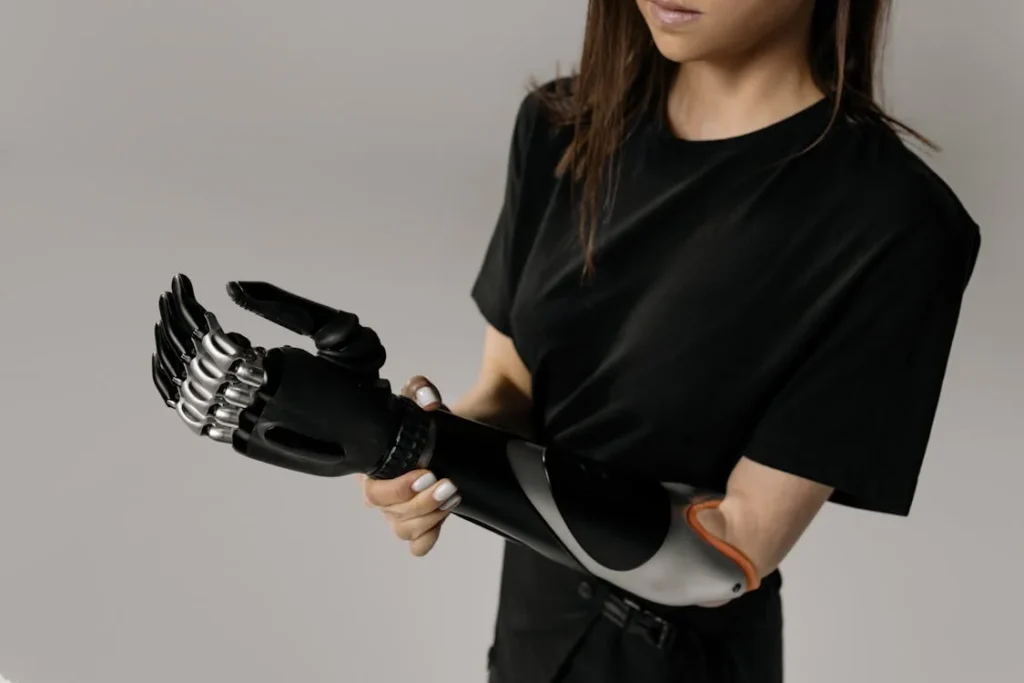A workplace should be a space where everyone can contribute their best, regardless of physical ability. In India, millions of people with disabilities struggle to find and keep jobs due to accessibility barriers. While laws and policies promote workplace inclusion, assistive technology is the real game-changer in making offices more accessible.
From voice-to-text software and AI-powered screen readers to ergonomic prosthetics and adaptive workstations, technology is transforming how people with disabilities work. It is no longer just about physical adjustments like ramps and wider doorways—it’s about digital tools, smart devices, and work environments that remove barriers completely.

Understanding Assistive Technology in the Workplace
Assistive technology is any tool, device, or software that helps people with disabilities perform tasks more easily.
In the workplace, this technology bridges the gap between challenges and productivity, allowing employees with disabilities to contribute effectively without unnecessary obstacles.
While accessibility has traditionally been viewed through the lens of infrastructure changes like ramps and elevators, today, digital and technological solutions play an equally important role.
The Evolution of Workplace Assistive Technology
Workplace assistive technology has evolved significantly over the past two decades. Earlier, support was limited to basic tools such as magnifiers for those with low vision or mechanical aids for individuals with mobility impairments.
Today, technology has advanced to include AI-powered screen readers, real-time speech recognition software, and bionic prosthetics that restore dexterity and control.
The digital shift has made many traditional office tasks easier for employees with disabilities. Voice-assisted computing enables individuals with mobility impairments to navigate digital platforms without using their hands.
Speech-to-text software allows those with hearing impairments to participate in meetings seamlessly. Cloud-based collaboration tools provide flexible working environments, ensuring that employees with disabilities are not restricted by physical barriers.
Assistive Technology for Different Types of Disabilities
For employees with visual impairments, screen readers and braille displays convert on-screen text into speech or tactile output.
Optical character recognition (OCR) technology enables printed text to be scanned and read aloud, making office documents accessible to individuals with blindness or low vision.
These tools are essential in industries where reading and writing are central to the job, such as finance, law, and content creation.
For individuals with hearing impairments, captioning and transcription services have transformed workplace communication.
Real-time captioning during virtual meetings ensures that employees who are deaf or hard of hearing can follow discussions without missing critical information.
Video conferencing platforms now integrate automated transcription features, reducing dependency on interpreters and making meetings more inclusive.
Employees with mobility impairments benefit from adaptive hardware such as ergonomic keyboards, hands-free computing solutions, and motorized desks that adjust to different height requirements.
Prosthetic advancements, such as bionic hands with intuitive control, empower individuals with limb loss to perform tasks that were previously challenging. These innovations enable employees to work efficiently, whether in an office, a factory, or a remote setting.
Neurodivergent individuals, including those with autism and ADHD, often struggle with traditional work environments due to sensory overload and rigid communication structures.
Assistive technology designed for cognitive accessibility includes noise-canceling devices, customizable workspaces with controlled lighting, and software that aids in task organization and time management.
These tools allow employees to work in an environment suited to their needs, improving focus and reducing stress.
The Growing Importance of Digital Accessibility
In modern workplaces, most tasks involve digital platforms, whether it is emailing, data analysis, or video conferencing. Ensuring digital accessibility is as important as making physical spaces barrier-free.
Many companies are now integrating accessibility features into their software, making work tools more inclusive from the start.
India’s growing tech ecosystem has also contributed to the development of localized assistive technologies.
Startups are creating AI-driven applications that support multiple Indian languages, ensuring that employees who speak regional languages can also benefit from accessibility tools.
As businesses continue to embrace digital transformation, assistive technology will play an even larger role in shaping how inclusive the workplace becomes.

The Role of Employers in Adopting Assistive Technology
While assistive technology is transforming workplaces, its impact depends largely on how employers implement and support these innovations.
Simply having the technology available is not enough—businesses must create an environment where employees feel comfortable using these tools without fear of stigma or resistance.
Building an Inclusive Workplace Culture
One of the biggest challenges in adopting assistive technology is the mindset of employers and colleagues. Many businesses still see accessibility as an extra effort rather than an essential part of their operations.
Employees with disabilities often hesitate to request assistive tools due to concerns about being seen as needing special treatment. This hesitation can lead to a lack of productivity and engagement.
To change this, companies must actively promote inclusivity as a core value. Leadership should emphasize that accessibility benefits everyone, not just individuals with disabilities.
When employees see that assistive technology is a standard part of the workplace, they are more likely to use it confidently. Sensitization programs and disability inclusion training can help shift perspectives and create a supportive work environment.
Integrating Assistive Technology into Hiring and Onboarding
Accessibility should begin at the hiring stage. Many traditional hiring processes unintentionally exclude candidates with disabilities.
For example, job application portals that are not screen reader-friendly create barriers for visually impaired applicants. Employers can address this by ensuring that their websites and application platforms meet accessibility standards.
Interviews should also be designed to accommodate different needs. Video interviews should include live captions for hearing-impaired candidates, and written assessments should be compatible with assistive reading tools.
Some companies have started offering remote interview options, allowing candidates to participate from a comfortable and accessible environment.
Once hired, employees with disabilities should have access to assistive tools from day one. Companies should proactively ask new hires about their accessibility needs and provide necessary accommodations without delay.
Ensuring a smooth onboarding process sets the tone for a truly inclusive work environment.
Customizing Workspaces with the Right Tools
Not all assistive technologies work the same for every individual. Employers must understand that different employees may require customized solutions.
Some might need voice-controlled software, while others may benefit from ergonomic furniture. Conducting accessibility audits and seeking employee feedback helps businesses identify which tools are most effective.
Flexible work arrangements also play a key role. Remote work options and hybrid schedules can significantly improve accessibility for employees with mobility challenges.
By allowing employees to work in environments best suited to their needs, companies create a more productive and inclusive workforce.
The Financial Aspect of Assistive Technology
A common misconception among employers is that assistive technology is expensive. In reality, many solutions are affordable and even cost-saving in the long run.
Government initiatives in India provide financial support for businesses that invest in workplace accessibility. Companies can claim tax benefits for accessibility-related expenses and receive funding under government schemes that promote disability inclusion.
In many cases, assistive technology improves efficiency, reducing the need for additional human assistance. A visually impaired employee using screen-reading software can complete tasks independently rather than relying on a co-worker for support.
Similarly, an employee with a mobility impairment using adaptive controls can work as efficiently as their peers. These investments not only benefit individuals with disabilities but also contribute to overall workplace productivity.
Collaborating with Assistive Tech Providers
Employers do not need to navigate accessibility challenges alone. Partnering with assistive technology providers, disability organizations, and workplace inclusion consultants can make the transition smoother.
Many tech companies in India specialize in workplace accessibility solutions, offering customized tools based on specific business needs.
By working closely with experts, businesses can stay updated on the latest advancements in assistive technology and continuously improve their accessibility strategies. Regular training sessions and technology updates ensure that employees receive the best possible support.

Government Support and Policies for Assistive Technology in Workplaces
While businesses play a critical role in adopting assistive technology, government policies and initiatives are equally important in making workplace accessibility a reality.
In India, several laws and programs encourage companies to implement assistive tools, ensuring that employees with disabilities have equal opportunities to thrive. However, awareness and enforcement of these policies remain a challenge.
The Rights of Persons with Disabilities (RPwD) Act, 2016
The RPwD Act, 2016, is India’s most comprehensive law on disability rights. It mandates that organizations, both public and private, take necessary steps to create accessible workplaces.
This includes providing assistive technology, modifying office infrastructure, and ensuring that digital platforms are usable by everyone.
The law also requires companies with 20 or more employees to have an Equal Opportunity Policy (EOP). This policy must outline how the company supports employees with disabilities, including details on assistive technology, workplace adjustments, and recruitment practices.
Despite this legal requirement, many companies either lack an EOP or fail to implement it effectively. Stronger enforcement and monitoring mechanisms are needed to ensure compliance.
Financial Incentives for Businesses
To encourage companies to invest in accessibility, the government offers financial incentives under various schemes. Businesses that hire persons with disabilities can receive wage subsidies and tax deductions.
The Employees’ State Insurance Corporation (ESIC) also provides financial support to employees with disabilities for assistive devices such as hearing aids, prosthetic limbs, and adaptive software.
In addition, the Ministry of Social Justice and Empowerment runs programs that offer grants to companies adopting workplace accessibility solutions.
However, many businesses are unaware of these benefits or find the application process too complex. Simplifying these procedures and increasing awareness can lead to greater adoption of assistive technology in workplaces.
Accessible India Campaign and Its Impact on Offices
The Accessible India Campaign, launched in 2015, aims to improve accessibility in public spaces, including workplaces.
While the campaign initially focused on making government buildings accessible, it has since expanded to encourage private organizations to adopt accessibility standards.
One of the campaign’s key objectives is digital accessibility. Government websites are now required to follow international web accessibility standards, ensuring that individuals with visual impairments can access information using screen readers.
This push toward digital inclusivity has influenced private companies as well, prompting many to improve the accessibility of their online platforms.
Skill Development and Assistive Tech Training
Assistive technology is only effective if employees know how to use it. Recognizing this, the Indian government has launched skill development programs that train persons with disabilities in using workplace technology.
The National Action Plan for Skill Development of Persons with Disabilities offers courses on digital tools, adaptive software, and industry-specific assistive solutions.
However, the challenge remains in bridging the gap between training and employment. Many businesses are hesitant to hire employees with disabilities due to misconceptions about productivity and costs.
Government-backed awareness campaigns and success stories can help change this mindset, showing that assistive technology enables employees to perform their tasks just as efficiently as their peers.
Strengthening Policy Implementation
Despite the existence of strong policies, enforcement remains weak. Many businesses continue to overlook accessibility requirements, either due to a lack of awareness or minimal penalties for non-compliance.
The government can address this issue by introducing regular accessibility audits, where companies are assessed on their assistive technology usage and workplace adjustments.
Stronger partnerships between the government, technology providers, and industry leaders can also accelerate progress.
By creating incentives for businesses to collaborate with assistive tech startups, India can build a more inclusive workforce while fostering innovation in the accessibility sector.

The Psychological and Social Impact of Assistive Technology in the Workplace
While the physical and digital benefits of assistive technology are well-documented, its psychological and social impact in the workplace is just as significant.
Employees with disabilities often face invisible barriers beyond accessibility—barriers related to confidence, workplace perception, and social inclusion.
Assistive technology is not just a tool for productivity; it also plays a critical role in fostering a sense of belonging, independence, and professional growth.
Boosting Confidence and Independence
One of the biggest challenges employees with disabilities face is the fear of being seen as dependent on others for their work. In many cases, this leads to hesitation in asking for help, which can affect performance and career progression.
Assistive technology removes this concern by giving employees the ability to perform their tasks without relying on colleagues for support.
For example, an employee with a mobility impairment using a voice-controlled computer can complete tasks without needing someone to assist with typing.
A visually impaired employee using screen reader software can navigate office systems independently.
These technologies empower employees by giving them control over their work, boosting their confidence and allowing them to focus on their professional skills rather than accessibility challenges.
Reducing Workplace Stigma and Bias
Even in workplaces that promote inclusion, unconscious bias and stereotypes about disability persist. Many employees with disabilities experience assumptions that they are less productive or need constant supervision.
Assistive technology challenges these misconceptions by demonstrating that employees with disabilities can work just as efficiently as their peers, if not more so when provided with the right tools.
When companies invest in accessibility solutions, they send a strong message that disability inclusion is a priority. This shifts workplace culture from seeing accessibility as an obligation to embracing it as a competitive advantage.
As assistive technology becomes more common, the stigma surrounding disability in professional environments continues to decrease.
Strengthening Team Collaboration and Inclusivity
Many workplace interactions depend on effective communication, which can sometimes be a challenge for employees with disabilities.
Assistive technology enhances teamwork by making communication seamless across all employees, regardless of ability. Real-time captioning in meetings ensures that hearing-impaired employees stay engaged in discussions.
AI-driven speech-to-text tools help employees with speech impairments participate more actively in conversations.
When assistive technology is integrated into daily operations, it benefits not just employees with disabilities but also their colleagues.
For instance, voice-to-text software helps employees take notes faster, and ergonomic office setups improve posture and comfort for everyone.
These shared benefits create a more inclusive workplace where accessibility is seen as an enhancement rather than an accommodation.
Increasing Career Advancement Opportunities
Employees with disabilities often face barriers when it comes to career growth. Inaccessible training programs, limited mentorship opportunities, and workplace biases contribute to fewer individuals with disabilities reaching leadership positions.
Assistive technology is changing this by giving employees equal access to training, development, and career progression opportunities.
E-learning platforms that incorporate accessibility features allow employees with disabilities to acquire new skills at their own pace. AI-powered coaching tools provide personalized feedback, helping individuals develop leadership capabilities.
By integrating assistive technology into professional development programs, companies create pathways for employees with disabilities to move into higher roles, ensuring that inclusion is present at every level of the organization.
Encouraging Open Conversations About Accessibility
One of the most overlooked benefits of assistive technology is that it creates opportunities for conversations about accessibility in the workplace.
When companies introduce new assistive tools, it encourages employees to discuss their experiences and share insights about what works and what doesn’t.
This dialogue fosters a culture of continuous improvement, where accessibility is not treated as a one-time initiative but as an ongoing commitment.
Workplaces that openly discuss accessibility also make it easier for employees to request the tools they need without hesitation.
When colleagues see accessibility solutions being implemented as part of standard operations, employees with disabilities feel more comfortable advocating for their needs.
The Future of Social Inclusion Through Assistive Technology
As assistive technology continues to advance, its role in social inclusion will only grow stronger. Workplaces that embrace these innovations will not only comply with accessibility standards but will also create environments where employees feel valued, respected, and empowered.
The true impact of assistive technology is not just in how it improves work efficiency, but in how it transforms workplace culture.
By investing in these solutions, businesses are not just breaking physical barriers—they are building an inclusive workforce where every employee has the opportunity to succeed.

The Role of Indian Startups and Innovation in Assistive Technology
India’s growing startup ecosystem has played a crucial role in advancing assistive technology for workplaces. Many entrepreneurs and tech innovators are developing affordable, user-friendly solutions that address the specific needs of employees with disabilities.
These innovations are not only transforming the way people with disabilities work but also making businesses more inclusive and productive.
AI and Machine Learning in Workplace Accessibility
Artificial Intelligence (AI) and machine learning have revolutionized accessibility by creating smarter assistive tools that adapt to individual needs.
AI-powered speech-to-text applications help employees with hearing impairments follow conversations in real time. These tools integrate with office communication platforms, automatically generating captions for video meetings and transcribing phone calls into text.
Similarly, AI-driven screen readers now offer more accurate and context-aware voice outputs, making it easier for visually impaired employees to navigate digital documents and web pages.
Indian startups specializing in AI are also developing chatbots that assist employees with disabilities in completing routine tasks, reducing dependence on co-workers for help.
Affordable Prosthetics for Employees with Limb Loss
Traditionally, advanced prosthetics were expensive and out of reach for many in India. However, companies like Robobionics have made bionic prosthetics more affordable and accessible.
A bionic hand that allows users to type, grip objects, and perform delicate tasks enables individuals with limb loss to participate fully in the workforce.
With 3D printing technology, the cost of prosthetic limbs has significantly reduced, allowing more employees with disabilities to benefit from these innovations.
These prosthetics are now designed to be lightweight, intuitive, and responsive, making them ideal for office environments where fine motor skills are required.
Smart Workstations and Adaptive Hardware
Many Indian startups are focusing on developing ergonomic and adaptive workstations that cater to employees with mobility impairments.
Motorized desks that adjust to different heights, touch-free door systems, and eye-tracking technology for hands-free computing are making workplaces more accessible.
Gesture-based controls allow individuals with limited hand movement to operate computers and other office devices effortlessly.
Customizable keyboards and adaptive mice provide a comfortable typing experience, reducing strain for employees with repetitive stress injuries or motor disabilities. These innovations ensure that physical barriers no longer limit productivity.
Digital Accessibility Tools for Indian Languages
One of the unique challenges in India’s accessibility landscape is the need for assistive technology that supports multiple languages. Many global accessibility solutions are designed primarily for English, leaving a significant portion of the Indian workforce underserved.
Startups in India are addressing this gap by developing voice recognition software, screen readers, and speech-to-text applications that support regional languages.
These innovations enable employees who speak Hindi, Tamil, Bengali, or other Indian languages to access workplace tools without language barriers.
By creating localized assistive technology, startups are ensuring that accessibility is inclusive of linguistic diversity, making workplaces more adaptable for a wider range of employees.
Virtual and Augmented Reality for Workplace Training
Virtual reality (VR) and augmented reality (AR) are now being used for workplace training and skill development for employees with disabilities.
VR simulations allow individuals to experience work environments before they join a company, helping them prepare for real-world tasks.
For example, employees with visual impairments can use VR-based training to familiarize themselves with office layouts, reducing navigation difficulties.
AR overlays can provide step-by-step visual guides for individuals with cognitive disabilities, making complex tasks easier to understand and perform.
Industry Collaboration with Startups
Indian businesses are increasingly collaborating with startups to integrate assistive technology into their workplaces. Many corporations have started pilot programs to test AI-powered accessibility solutions, adaptive workstations, and digital inclusion tools.
These partnerships allow companies to stay ahead in workplace accessibility without having to develop these technologies in-house.
Government initiatives like the Startup India program have also provided funding and mentorship for accessibility-focused startups, encouraging more innovation in this space.
By supporting these ventures, India is creating a stronger foundation for inclusive employment, ensuring that technology is used not just for business growth but also for social impact.

The Future of Assistive Technology in Indian Workplaces
The role of assistive technology in workplace accessibility is expanding rapidly, and India is at a crucial point where innovation and policy must work together to create lasting change.
While significant progress has been made, there is still much work to be done in ensuring that accessibility is not just an option but a standard across all industries.
The future of assistive technology in Indian workplaces will depend on technological advancements, stronger enforcement of accessibility policies, and a shift in how businesses view inclusion.
The Integration of AI and Automation
As artificial intelligence and automation continue to advance, assistive technology is expected to become even more intuitive and responsive.
AI-powered virtual assistants are already helping employees with disabilities navigate their work more efficiently. In the future, these systems will become more personalized, adapting to individual user preferences and work habits.
For employees with visual impairments, AI-driven object recognition tools will allow them to interact more seamlessly with their surroundings.
Gesture-controlled technology will improve accessibility for those with limited mobility, enabling them to operate computers and machinery without traditional input devices. As AI continues to evolve, it will remove many of the existing barriers to workplace accessibility.
The Growing Role of Remote Work and Hybrid Models
The COVID-19 pandemic changed how companies operate, and one of the most significant shifts has been the normalization of remote work.
For employees with disabilities, this has created opportunities that were previously unavailable. Many individuals who faced challenges commuting to inaccessible office spaces are now able to work efficiently from home with the help of assistive technology.
As hybrid work models become the new standard, businesses must ensure that remote employees with disabilities receive the same level of accessibility support as those in physical offices.
This includes providing assistive software, ergonomic home office setups, and accessible digital communication tools. The future workplace will need to be flexible, allowing employees to choose the work environment that best suits their needs.
Expanding Awareness and Adoption in Small Businesses
While large corporations and multinational companies have started integrating assistive technology, small and medium-sized enterprises (SMEs) in India still lag in adopting accessibility measures.
Many smaller businesses either lack awareness of assistive tools or believe that implementing them is costly.
To address this gap, the government and private sector must work together to provide affordable solutions and training programs for SMEs.
Cloud-based assistive software and open-source accessibility tools can help smaller businesses create inclusive workplaces without requiring heavy investments.
As awareness increases, more businesses will recognize the long-term benefits of inclusive hiring and accessibility.
Strengthening Accessibility in Education and Workforce Training
The future of workplace accessibility also depends on how well individuals with disabilities are prepared for employment.
Many assistive technologies that are useful in offices are still not widely available in educational institutions. Students with disabilities often struggle to access learning materials, limiting their career opportunities.
Integrating assistive technology into schools, colleges, and vocational training centers will ensure that individuals with disabilities enter the workforce with the skills they need to succeed.
More partnerships between businesses and educational institutions can create pathways for employment, allowing students to train with the assistive tools they will use in their future workplaces.
The Shift Toward Inclusive Design Thinking
A major shift in workplace accessibility is the move from making adjustments after hiring to designing workplaces that are accessible from the start.
This concept, known as inclusive design thinking, focuses on creating work environments where accessibility is naturally integrated rather than being an afterthought.
Companies that embrace inclusive design will incorporate assistive technology into their daily operations, ensuring that employees with disabilities do not have to request accommodations—they will already be in place.
Whether through universally accessible office layouts, AI-driven workflow automation, or built-in accessibility features in workplace software, inclusive design will shape the future of accessibility in India.
Collaboration Between Government, Businesses, and Technology Providers
The full potential of assistive technology can only be realized when businesses, government agencies, and tech providers work together.
Government incentives should continue to evolve to support companies that invest in accessibility, while businesses should actively seek partnerships with assistive technology innovators.
The future of accessibility in Indian workplaces is promising, but progress depends on action. Employers who take steps today to implement assistive technology will not only create a more inclusive workforce but also gain a competitive advantage in the long run.
Accessibility is not just about compliance—it is about building a better, more efficient, and more diverse work environment for everyone.
Conclusion
Assistive technology is transforming workplace accessibility in India, making it easier for employees with disabilities to contribute, collaborate, and advance in their careers. From AI-powered tools and adaptive hardware to bionic prosthetics and digital accessibility solutions, these innovations are breaking barriers and reshaping how businesses approach inclusion.
However, technology alone is not enough. Employers must actively integrate these tools into their workplaces, provide proper training, and foster a culture where accessibility is a priority, not an afterthought. Government policies and financial incentives support this shift, but stronger enforcement and awareness are needed to drive widespread adoption.
The future of workplace accessibility in India depends on continuous collaboration between businesses, technology providers, and policymakers. Companies that invest in assistive technology will not only empower employees with disabilities but also unlock new levels of innovation, productivity, and diversity. Accessibility is no longer just a compliance requirement—it is a strategic advantage that benefits everyone.



